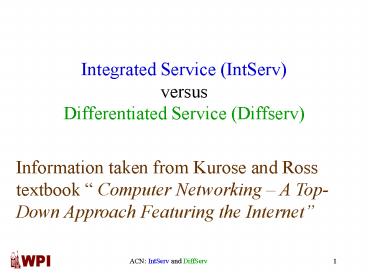Integrated Service (IntServ) versus Differentiated Service (Diffserv) - PowerPoint PPT Presentation
Title:
Integrated Service (IntServ) versus Differentiated Service (Diffserv)
Description:
... traffic characterization is given by a leaky bucket with parameters (r,b) and ... R at each router and a bound on maximum queuing via the leaky bucket parameters. ... – PowerPoint PPT presentation
Number of Views:380
Avg rating:3.0/5.0
Title: Integrated Service (IntServ) versus Differentiated Service (Diffserv)
1
Integrated Service (IntServ) versusDifferentiate
d Service (Diffserv)
Information taken from Kurose and Ross textbook
Computer Networking A Top-Down Approach
Featuring the Internet
2
Integrated Service (IntServ)
- IntServ framework was developed within IETF to
provide individualized QoS guarantees to
individual sessions. - provides services on a per flow basis where a
flow is a packet stream with common source
address, destination address and port number. - IntServ routers must maintain per flow state
information.
3
IntServ
- two key IntServ features
- Reserved Resources
- the router must know the amount of its resources
currently reserved for on-going sessions. - standard resources link capacity, router buffers
- Call Setup
- A flow requiring QoS guarantees must be able to
reserve sufficient resources at each router on
path to ensure QoS requirements are met.
4
Call Setup details
- Call Setup also referred to call admission
requires participation of each router on the
path. - steps in call setup process
- Traffic characterization and specification of QoS
- Rspec (R for reserved) defines the specific QoS
being requested by a connection. - Tspec (T for traffic)characterizes the traffic
the sender will be sending into the network or
the traffic that the receiver will be receiving
from the network.
5
Call Setup details
- Signaling for call setup
- A sessions Tspec and Rspec must be carried to
the - routers where resources will be reserved.
- RSVP is the signaling protocol of choice.
- Per-element call admission
- Once a router receives Rspec and Tspec for a
session, it decides whether or not to admit the
call.
6
IntServ traffic classes
- Best Effort service
- Controlled Load service
- A flow receives a quality of service closely
approximating QoS that flow would receive from an
unloaded network element. - This is fine when the network is lightly loaded,
but the service degrades quickly as network load
increases.
7
Intserv traffic classes
- 3. Guaranteed Service RFC2212
- Provides firm bounds on queueing delays that a
packet will experience at a router. - A sources traffic characterization is given by a
leaky bucket with parameters (r,b) and requested
service is characterized by transmission rate, R.
This characterization is requiring a forwarding
rate R at each router and a bound on maximum
queuing via the leaky bucket parameters.
8
Differential Service (DiffServ)
- In DiffServ, flows are aggregated into classes
that receive treatment by class. - More complex operations are pushed out to edge
routers and simpler operations done by core
routers. - motivated by
- scalability, flexibility, and better-than-best-eff
ort service without RSVP signaling.
9
DiffServ functional elements
- edge functions
- packet classification
- packet marking
- traffic conditioning
- core functions
- forwarding based on per-hop behavior (PHB)
associated with packets class
10
DiffServ edge functions
- packet classification
- classifier selects packets based on values in
packet header fields and steers packet to
appropriate marking function - how classifier obtains the rules for
classification not yet addressed RFC 2475 uses
term behavior aggregate rather than class of
traffic. - administrator could load table of source
addresses - done under control of TBA signaling protocol
11
Meter
Shaper/ Dropper
Forward
Classifier
Marker
Packets
Drop
Logical view of packet classification and traffic
conditioning at the edge router
12
DiffServ edge functions
- packet marking
- DS field value set accordingly at the marker.
- may wish to limit injection rate of specifically
marked packets into network, i.e., user promises
to keep sending rate within a traffic profile. - metering function compares the incoming packet
flow with negotiated traffic profile. - This implies a traffic shaper/dropper function.
13
DiffServ core routers
- Routers define packet classes and separate
incoming packets into classes. - Treatment is done per class.
- Per-hop behavior (PHB) defines differences in
performance among classes. - externally observable performance criteria that
do not specify internal implementation mechanisms
at router.
14
per-hop behavior (PHB)
- examples
- A given class receives at least 10 of outgoing
link bandwidth over time interval. - Class A packets have strict priority over class B
packets. - current proposals for PHB
- Expedited Forwarding (EF) PHB
- Assured Forwarding (AF) PHB
15
Expedited Forwarding (EF) PHB
- EF specifies that the departure rate of class of
traffic from router must equal or exceed a
configured rate independently of the traffic
intensity of any other classes. - This implies some form of isolation among traffic
classes. - EF abstraction a link with a minimum
guaranteed link capacity
16
Assured Forwarding (AF) PHB
- Assured Forwarding divides traffic into four
classes where each AF class is guaranteed some
minimum resources (capacity, buffering). - Within each class, packets are further
partitioned into one of three drop preference
categories. Congested routers then drop/mark
based on their preference values.
17
Assured Forwarding (AF) PHB
- Determining resource allocation per class of
service must be done with knowledge about traffic
demands for the various traffic classes.































